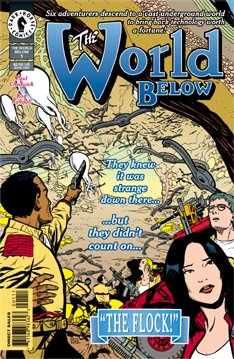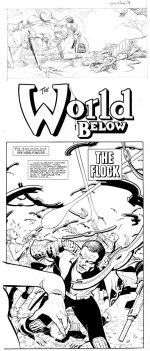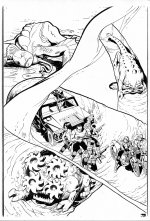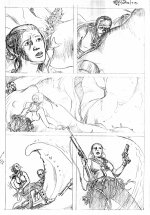About "The World Below"
 Here is, directly from Paul, the latest scoop on his new sci-fi/adventure/humor series The World Below, beginning monthly in March 1999.
Here is, directly from Paul, the latest scoop on his new sci-fi/adventure/humor series The World Below, beginning monthly in March 1999.
Briefly:
The Comic: The World BelowFrequency: Monthly, ongoing
Stories: One complete in each issue
Genre: wild, not-deadly-serious SF adventure
In a nutshell: Six misfit adventurers seek technology for a nervous multimillionaire.
Setting: A cavernous world underneath Washington State filled with odd machines, monstrous aliens and "altered" humans.
Creator: Paul Chadwick (inks by Ron Randall)
Quote: "I'm not in the mood for epics. This comic is for people like me, who want a grabber, a story, and a conclusion that they can read (and comprehend) in a sitting. Simplicity, wonder, cleverness; these are my goals."--PC
Starts: March 1999
Chadwick takes to The World Below
This March Dark Horse begins publishing Paul Chadwick's new monthly series, The World Below. Unlike Chadwick's familar Concrete;, it's action-filled, wildly inventive SF adventure.The ongoing series, inked by Ron Randall, begins what Chadwick hopes to be " the next chapter in my career; the idea is rich enough in story material I plan on doing it full-time for at least two years. Further, if I can."
The tag line explains it: "Six adventurers descend to a vast underground world to bring back technology worth a fortune. But first they must survive."
The Team of Six, three of them women, are sent there by computer magnate Charles Hoy. His patents came from an eagle-sized robot that emerged from this hidden world beneath Washington state. Now the value of his patents is eroding. He needs another technological "miracle" from down there.
What Hoy doesn't know is that this was a colony of sunlight-averse aliens. They imported creatures and self-replicating machines from across the galaxy. Then they mysteriously left (or perhaps died). Creatures and machines, and humans plucked from the surface, clash and struggle in the now chaotic World Below. It means trouble for the Team of Six.
It's a setup where anything can happen. The first issue finds the Team hectored by a flock of the flying robots. The second, they face rock-eating monsters. The third is a psychodrama in which the men are irresistably called to climb a spire of rock with a bizarre secret on top. The fourth issue, they dodge a tanklike machine that wants to cook them like sausages.
"Each story is complete," says Chadwick. "I crave that simplicity, amid the sometimes daunting complexities of comics in this mature phase of our artform. A joe can pick up issue 20, read it cold, and 'get it;' that's my goal."
Just as Concrete is not exactly an on-genre superhero, Chadwick promises a unique slant on SF adventure. "My personal obsessions manifest in my work no matter what I do. I can't avoid it; it's often unconscious. This will be no different, except that their symbolic form will likely be fantastical creatures and machines that are rather fun to look at."

Paul Chadwick talks about The World Below
This March Paul Chadwick's new ongoing series debuts (this month it is being solicited to comics retailers). Best known for the multiple-award-winning Concrete series, Chadwick is , as revaled below, taking a very different tack. One of comics' most honored creators is hoping to suprise us.
SE-G: I know this is supposed to be an interview where we talk about your new series The World Below, but there's something we should get out of the way first: what are your plans for Concrete?
PC: I've said it before: I consider Concrete my life's work. But I need a break now and then to keep fresh; and it's a time in my career when it behooves me to suprise people. A reason to make a little noise and get some attention.
We'll see how long The World Below goes; a couple of years at least, I hope. Ideally I would then continue writing it, and have others draw it. But I'll be anxious to get back to drawing the big rock guy by then.
The next Concrete series will be a story of amnesia and survival in the wilderness, "Stars Over Sand." But look for it no sooner than next century.
SE-G: How do you think fans of Concrete will respond to the new series? Is this something you've thought about?
PC: Actually, no. It's rather less cerebral. Less sitting around ruminating -- none, in fact. But it has an integrity of its own, I think. It comes from a different part of my mind.
SE-G: When did the idea for The World Below hit you, and when did you know you really wanted to do this?
PC: In December 1997, after finishing Strange Armor, I deliberately worked on broadening my creative options. I wrote up several pitches for Dark Horse, including a Star Wars series and an Aliens series. I wrote much of Gifts of the Night, a visionary fable that John Bolton painted and is currently appearing from Vertigo.
I also did a charcoal drawing each night, drawn in an exploratory, painterly way, trying to avoid conscious thought. My inspiration was the Austrian Symbolist Alfred Kubin, who produced reams of strange drawings. I am attracted to the idea of drawing straight from the subconscious.
I didn't get as far out as Kubin -- he was one sick puppy, as they say. But in a few I reached that quiet, dark, vast place where I dream. And The World Below, when it's working, comes from that place. I started a notebook and pitched it the next February.
This is tied up with my mental and emotional development in ways I don't fully understand. The series echoes many inputs of my youth, from Kirby super-science comics to Wolverton's grotesques, a Stephen King novella, The Mist, and William Hope Hodgson's 1912 epic SF novel, The Night Land; and George Metzger's wonderful, wordless story, Mal-Ig, from Bill Spicer's Graphic Story Magazine. circa 1972.
 SE-G: Can you give us a quick outline of what fans can expect from this series? What's the basic premise?
SE-G: Can you give us a quick outline of what fans can expect from this series? What's the basic premise?
PC: Fifteen years ago an eagle-sized flying machine emerged from a sinkhole in rural Washington State. It came into the hands of Charles Hoy. He had it analyzed. Its technology yielded patents which made his fortune.
Now the value of the patents has eroded. Hoy needs another technological treasure. Cameras he's lowered into the sinkhole suggest there's more for the taking, in the vast world down there. He recruits six people and sends them down to retrieve some.
What they don't know is that this was a colony for sunlight-shunning aliens who, over the centuries, imported creatures and robots from across the galaxy. Something awful happened; order collapsed; chaos reigns in The World Below. The poor saps haven't a clue what they're getting into!
SE-G: The World Below involves quite a cast: the Team of Six, their employer, and the strange entities in this world below the surface of the earth. Can you give examples of the characters (human or otherwise) roaming down there?
PC: Sentient balloons, plants and patched-together monsters the size of houses. Things that were once human but are now sad, boneless blobs. Descendents of humans plucked from the surface world over the centuries, now domesticated as servants, workers, pets and food for other species. Robots designed to seek meat on the hoof and cook it. Living rock drills.
SE-G: And the Team of Six - who are they?
PC: They're a fractious, ad-hoc group who agree on little but mutual survival and the big payoff awaiting them after they bring back the gadgets Hoy wants.
A burnt-out doctor, a saintly tomboy, a crazy-making beauty, a displaced tank commander, an insecure hothead and a tech geek. Three women, three men. Things are going to happen between them.
SE-G: From your own sketchy descriptions of the cast, I can't tell which one is supposed to be the "hero" figure - because they each seem pretty normal - except for Barclay Hassler. He's clearly the leader, but he also seems tortured by events of his past, and I'm guessing this will eventually catch up to him.
PC: They'll all have moments of heroism, and of...less virtuous conduct. They're all basically decent, but screwed up.
Hassler is a Gulf War vet whose career hit the rocks after he started suffering headaches, fatigue, rashes and other symptoms of Gulf War Syndrome. He's the iron man type, hides his terrible suffering, and fears for the motley group he feels responsible for. Great pain, of course, is the stuff of drama. Poor Hassler is going to go through the wringer in this series.
Once or twice each issue I flash back to the characters' surface lives. But it's intentionally rationed; the weirdness of The World Below is the meat, characterization the seasoning, here. Still, even monster fighters should have motives, secrets and quirks.
 SE-G: Is this the first time you've written a "team adventure" sort of series?
SE-G: Is this the first time you've written a "team adventure" sort of series?
PC: Yep. Hope I don't blow it.
SE-G: I understand you're planning on making each issue essentially self-contained. Why?
PC: It's something I crave myself when I pick up a comic; a complete reading experience. Wrapping things up neatly each time is tough, a discipline I compare to a three-minute ballad or a good storytelling commmercial. I kind of like that challenge.
SE-G: Is this something you think has been missing from comics?
PC: Our art form's in a mature state. We expect a lot of our audience. At one end of the spectrum, Kingdom Come required thirty years of attentive comics reading to appreciate its nuances and subtext. Even something as inviting as Bone asks you to sign up for ten years of reading to get the whole epic.
Amidst the farrago of information in my life, I find I seldom have the fight in me to try to wrap my mind around little pieces of complicated, ambitious, long-running narratives, puzzling out what I've missed. I'm in the mood for something short, snappy, complete.
There are comics like that. But I hope to push this easy-read quality as far as I can.
I tell each story three times. The cover puts across the premise. I use word balloons, blurbs, every creaky Silver-age device. The splash page tells the story another way, stressing the moment of crisis. The following nineteen pages are what led up to it, the details, grace notes, moments of (I hope) humanity, and the reslolution. Like a newspaper story: headline, subhead, copy.
I want somebody coming to it cold in issue twenty to "get it" instantly.
SE-G: Any additional thoughts?
PC: I'd like to mention Ron Randall, my collaborator. I've always hated to surrender a smidgeon of control over my work, but it's necessary to do a monthly book. Seeing Ron's inks makes me wonder why I sweated it so.
Ron's a crisp realist of the Al Williamson school (though actually, he's a Kubert alumnus). He has the essential ingredient for a great inker: he's a draughtsman himself. I tell him to correct all my mistakes, and already he's realigning my floating eyes and such. He's an old friend, too, who helped launch Dark Horse with his SF strip Trekker.
My wife Elizabeth and I will color the book. Warm, bright, reds and oranges and olives and earth tones. This ain't noir; it's a smart, good time.